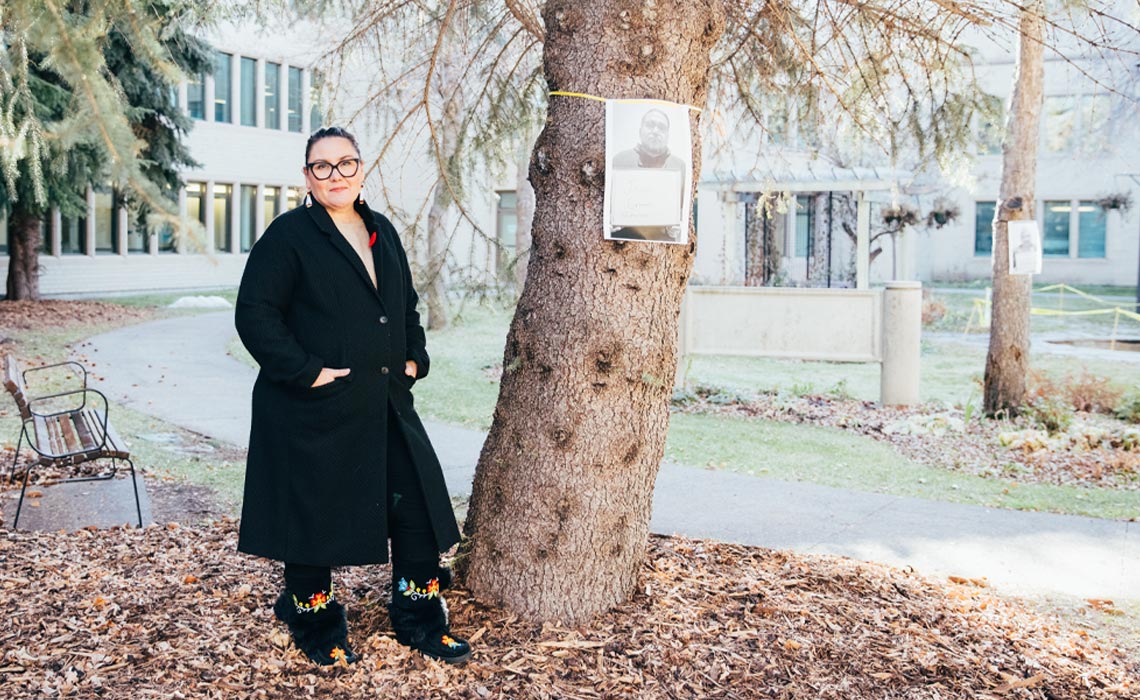Art installation honours the contributions and sacrifices of Indigenous veterans

It’s estimated that more than 7,000 Indigenous people served in Canada’s military efforts during the First World War, Second World War and the Korean War. Among those who served was James Waucaush, who took part in the bloody and brutal Dieppe Raid in August 1942.
Waucaush was captured during the offensive and spent the remainder of the war in a POW camp where he witnessed atrocities that were commonplace. He survived the camps and a ruthless 22-day hunger march before being rescued in May 1945.
Jaime Waucaush-Warn, an assistant professor of Indigenous studies at Mount Royal University, is named for her grandfather. Unfortunately, she never had the chance to know him. Four years after returning from the war, he died in a car accident. But Waucaush-Warn is carrying on his legacy through a temporary art installation on the MRU campus aiming to honour and recognize Indigenous veterans as part of National Indigenous Veterans’ Day (Nov. 8) commemorations.
The project is part of her commitment to the students in her Indigenous art class, to have them understand the process of making art and how it can transform the individual creating it. This piece, she says, is focused on the Indigenous community at MRU and Indigenous community members with connections to the school.
“I approached students, faculty and staff, and those who are returning to the community, which many of us are, and asked if they wanted to honour someone from their own community. So, I’m currently taking their photos and portraits from the chest up, in black and white, and writing on a whiteboard the name of their loved ones who have served.”
Waucaush-Warn says it wasn't difficult finding the inspiration to create the installation, even if the path to its completion wasn’t clear at the start.
“I didn’t know how I was going to come to the project. I just knew that since I arrived at MRU, there has been little to no acknowledgement of Indigenous Veterans’ Day on campus. Both my grandfathers fought in the war. They are Indigenous veterans, and I wanted to make sure we were acknowledging those who served in our community. We have over 800 to 900 Indigenous faculty, students and staff at MRU, and I knew there would be others who would want to acknowledge their loved ones who served in the First and Second World Wars and the Korean War.”
Aboriginal Veterans’ Day was established in Manitoba in 1994. It has since spread across the country to the other provinces and was renamed National Indigenous Veterans’ Day. It is recognized annually on Nov. 8 to acknowledge the many contributions and sacrifices of Canada’s Indigenous Peoples, not only in the war effort but in its peacekeeping missions as well.

John Fischer, MRU’s interim associate vice-president of indigenization and decolonization, stresses the importance of the day cannot be understated, considering how little recognition was given to Indigenous veterans prior.
“There was a point in time where they were not recognized for their service. Also, during World Wars One and Two and the Korean Conflict, Indigenous people did not hold the same rights as other Canadians, yet they enlisted. They also did not receive the same benefits upon return, like some of the land grants and other things that veterans could apply for at the time. That did not happen for Indigenous people.”
Fischer has a personal connection to National Indigenous Veterans’ Day and is part of the art installation created by Waucaush-Warn and her students. His ancestors were members of the Canadian military, including his father, who fought in Korea, along with his uncles and brother, who served as part of Canada’s peacekeeping missions.
“Recognizing that this is part of our families is something that Jaime’s art installation project has done in a thoughtful and considerable way – by naming the people who we know and that we’re connected with, and who have been part of the military engagements in Canada,” Fischer says.
For Waucaush-Warn, she hopes the project will educate and encourage people to explore the significant contributions made not only by Indigenous veterans, but Indigenous people, particularly concerning the development of the country. The traumatic experiences, such as residential schools, the ’60s scoop, and the numerous missing and murdered Indigenous women, are well documented. But their role in building the country through their labour and service often goes unacknowledged.
“We, by our labours, helped develop Canada. When we weren’t being hired, we were put in the labour force to help develop the country, like on farms. I grew up on a tobacco farm in Southern Ontario. And so did many of the women in my family, but that wasn’t discussed. The same thing happened in this territory, Treaty 7, with the sugar beet farms and the Blackfoot people. It's a missing piece. So, I guess I’m trying to raise awareness.”
Waucaush-Warn's art installation is available for public viewing on Nov. 8 in the Dr. John H. Garden Memorial Park. It will serve as a powerful tribute to Indigenous veterans and a reminder of their invaluable contributions to Canada. It also stands as a testament to the ongoing journey of reconciliation, honouring the past and inspiring a better future.

